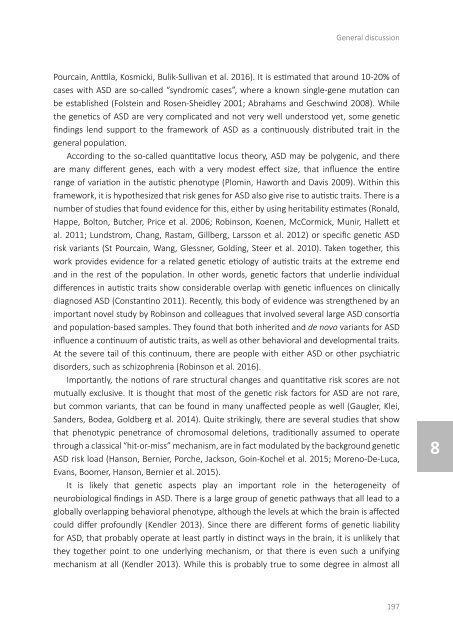On the Spectrum
2lm5UyR
2lm5UyR
Create successful ePaper yourself
Turn your PDF publications into a flip-book with our unique Google optimized e-Paper software.
General discussion<br />
Pourcain, Anttila, Kosmicki, Bulik-Sullivan et al. 2016). It is estimated that around 10-20% of<br />
cases with ASD are so-called “syndromic cases”, where a known single-gene mutation can<br />
be established (Folstein and Rosen-Sheidley 2001; Abrahams and Geschwind 2008). While<br />
<strong>the</strong> genetics of ASD are very complicated and not very well understood yet, some genetic<br />
findings lend support to <strong>the</strong> framework of ASD as a continuously distributed trait in <strong>the</strong><br />
general population.<br />
According to <strong>the</strong> so-called quantitative locus <strong>the</strong>ory, ASD may be polygenic, and <strong>the</strong>re<br />
are many different genes, each with a very modest effect size, that influence <strong>the</strong> entire<br />
range of variation in <strong>the</strong> autistic phenotype (Plomin, Haworth and Davis 2009). Within this<br />
framework, it is hypo<strong>the</strong>sized that risk genes for ASD also give rise to autistic traits. There is a<br />
number of studies that found evidence for this, ei<strong>the</strong>r by using heritability estimates (Ronald,<br />
Happe, Bolton, Butcher, Price et al. 2006; Robinson, Koenen, McCormick, Munir, Hallett et<br />
al. 2011; Lundstrom, Chang, Rastam, Gillberg, Larsson et al. 2012) or specific genetic ASD<br />
risk variants (St Pourcain, Wang, Glessner, Golding, Steer et al. 2010). Taken toge<strong>the</strong>r, this<br />
work provides evidence for a related genetic etiology of autistic traits at <strong>the</strong> extreme end<br />
and in <strong>the</strong> rest of <strong>the</strong> population. In o<strong>the</strong>r words, genetic factors that underlie individual<br />
differences in autistic traits show considerable overlap with genetic influences on clinically<br />
diagnosed ASD (Constantino 2011). Recently, this body of evidence was streng<strong>the</strong>ned by an<br />
important novel study by Robinson and colleagues that involved several large ASD consortia<br />
and population-based samples. They found that both inherited and de novo variants for ASD<br />
influence a continuum of autistic traits, as well as o<strong>the</strong>r behavioral and developmental traits.<br />
At <strong>the</strong> severe tail of this continuum, <strong>the</strong>re are people with ei<strong>the</strong>r ASD or o<strong>the</strong>r psychiatric<br />
disorders, such as schizophrenia (Robinson et al. 2016).<br />
Importantly, <strong>the</strong> notions of rare structural changes and quantitative risk scores are not<br />
mutually exclusive. It is thought that most of <strong>the</strong> genetic risk factors for ASD are not rare,<br />
but common variants, that can be found in many unaffected people as well (Gaugler, Klei,<br />
Sanders, Bodea, Goldberg et al. 2014). Quite strikingly, <strong>the</strong>re are several studies that show<br />
that phenotypic penetrance of chromosomal deletions, traditionally assumed to operate<br />
through a classical “hit-or-miss” mechanism, are in fact modulated by <strong>the</strong> background genetic<br />
ASD risk load (Hanson, Bernier, Porche, Jackson, Goin-Kochel et al. 2015; Moreno-De-Luca,<br />
Evans, Boomer, Hanson, Bernier et al. 2015).<br />
It is likely that genetic aspects play an important role in <strong>the</strong> heterogeneity of<br />
neurobiological findings in ASD. There is a large group of genetic pathways that all lead to a<br />
globally overlapping behavioral phenotype, although <strong>the</strong> levels at which <strong>the</strong> brain is affected<br />
could differ profoundly (Kendler 2013). Since <strong>the</strong>re are different forms of genetic liability<br />
for ASD, that probably operate at least partly in distinct ways in <strong>the</strong> brain, it is unlikely that<br />
<strong>the</strong>y toge<strong>the</strong>r point to one underlying mechanism, or that <strong>the</strong>re is even such a unifying<br />
mechanism at all (Kendler 2013). While this is probably true to some degree in almost all<br />
8<br />
197


